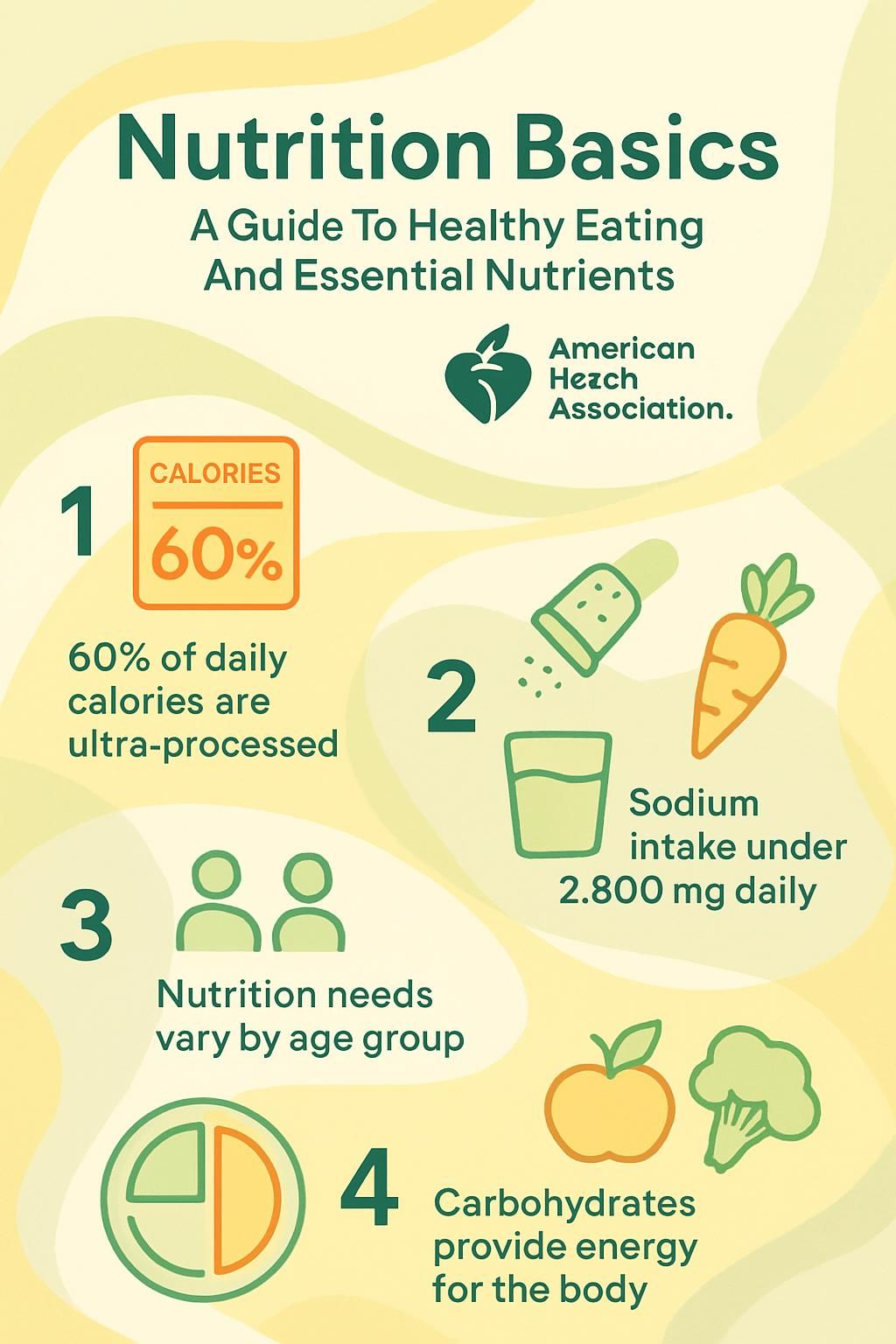Nutrition Basics: A Guide To Healthy Eating And Essential Nutrients By The American Heart Association
Our Nutrition Assistant AI Suite will transform your body. You will lose fat, get toned, and build muscle. Gain confidence and optimal health.
You might feel unsure about what to eat or how to start healthy meals. The American Heart Association says following nutrition basics can lower heart disease risk and support daily energy. This guide covers food groups, essential nutrients like vitamin and protein, the benefits of a balanced diet, and how tools such as MyPlate make healthy eating easier.
Keep reading to find simple steps you can use today for yourself and your family.
Key Takeaways
- The American Heart Association recommends a balanced diet with whole grains, lean proteins, fruits, vegetables, low-fat dairy, and healthy fats to reduce heart disease risk.
- Ultra-processed foods provide about 60 percent of daily calories for many Americans and link to higher rates of obesity, diabetes, high blood pressure, and heart disease (2020–2025 Dietary Guidelines).
- Essential nutrients include carbohydrates for energy, protein for tissue repair, healthy fats for organ protection, vitamins and minerals for immunity, and water for hydration.
- Adults should limit sodium to less than 2,300 mg per day and keep added sugars low, as advised by the American Heart Association.
- Needs change with age. Kids need extra calcium and protein for growth. Older adults may need more calcium, vitamin D, fiber, and sometimes B12.

What is Nutrition?

Nutrition explains how your body gets nutrients from food to stay healthy. Understanding nutrition helps you choose a balanced diet and build a stronger body.
What does nutrition mean?
Nutrition is the science of how food and nutrients affect health, growth, and energy. Your body handles what you eat through intake, digestion, absorption, metabolism, and excretion. Each nutrient has a job. Carbohydrates supply quick energy. Proteins act as building blocks for muscles and tissues.
Six essential nutrients form the core of a healthy diet: carbohydrates, protein, fat, vitamins, minerals, and water. Fats include saturated fat and different fatty acids. Vitamins include vitamin A and vitamin D. Minerals include calcium and iron. Experts with the American Heart Association advise eating a variety of whole foods from every food group to power daily life and reduce chronic disease risk.
If you swap weekly takeout for simple home-cooked meals, you may notice more steady energy. Replacing refined grains with brown rice or whole-wheat pasta can help you feel and perform better in everyday activities.
“You are what you eat applies not just to your waistline but also to long-term health.”
Why is nutrition important for overall health?
Healthy foods supply the nutrients your body needs to stay strong. Good nutrition supports your immune system, bone strength, and brain function. The American Heart Association notes that smart eating patterns help prevent heart disease and high blood pressure.
Fill your routine with vegetables, fruits, whole grains, lean proteins like fish or beans, low-fat dairy, and healthy fats. Diets high in ultra-processed food raise the risk for obesity and some cancers. Choosing more fresh produce and whole foods lowers those risks. Following the Dietary Guidelines for Americans helps you get key micronutrients without excess sugar or salt.
Essential Nutrients Your Body Needs
Your body relies on essential nutrients to move, think, and repair. Knowing the nutrients your body needs can help you make better choices every day.
How do carbohydrates provide energy for cells and organs?
Carbohydrates are your main energy source. After you eat oatmeal, brown rice, or sweet potatoes, your body breaks the starch into glucose. This simple sugar travels in your blood to fuel muscles, power your brain, and support organ function.
The 2020–2025 Dietary Guidelines for Americans encourage you to make at least half of your grains whole, such as quinoa or whole-wheat bread. Complex carbohydrates digest slowly, so they deliver steady energy instead of spikes and crashes. Whole grains also add fiber, which keeps you full and supports digestion.
For school, work, or sports, a balanced breakfast with whole grains can improve focus compared to skipping the meal. The American Heart Association suggests choosing complex carbs over refined ones to support healthy cholesterol levels and weight control.
“Whole grains keep students energized on busy days,” says Melissa Martinez, a registered dietitian who counsels teens across the United States.
What role do proteins play in building and repairing tissues?
After carbohydrates deliver energy, proteins support repair and growth. Protein builds and maintains tissues like muscle, skin, and organs. Exercise and daily wear create small tears in muscle fibers. Protein helps them heal.
Lean meats, poultry, fish like trout or salmon, beans, soy, and eggs offer high-quality protein. Plant-forward choices can improve heart health while meeting your needs. Young athletes and growing kids often require more protein for muscle maintenance and development. Aim for sensible portions to get the nutrients you need without too many calories.
Shifting from a low-carbohydrate diet heavy in red meat to a Mediterranean style plan can reduce soreness and support recovery. You might try yogurt with berries and nuts at breakfast, and beans or lentils at lunch or dinner.
How do fats help with energy storage and organ protection?
Fats store energy for later use and protect organs. Healthy fats from nuts, seeds, avocados, and olive oil supply concentrated calories. Gram for gram, fat provides more than twice the energy of carbs or protein.
A layer of body fat cushions your heart, kidneys, and other organs. Fat also helps your body absorb fat-soluble vitamins, including A, D, E, and K. The American Heart Association recommends sources of omega-3 fatty acids, like fatty fish, to support cardiovascular health. Keep portions moderate because fats are energy dense.
Why are vitamins important for the immune system and cells?
Vitamins act like helpers for your cells and immune system. Vitamin C, found in citrus and berries, supports immune defenses. Vitamin D, made in skin from sunlight and found in some foods, supports bones and immune control.
Experts with the Academy of Nutrition and Dietetics encourage variety to cover your vitamin needs. Deficiencies can weaken immunity and slow recovery from illness. If you build meals around fruits, vegetables, whole grains, and lean proteins, you support cell growth and strong defenses.
How do minerals strengthen bones and regulate body processes?
Minerals support bones, nerves, muscles, and fluid balance. Calcium strengthens bones and teeth. You can get it from low-fat dairy, leafy greens, and fortified plant milks. Older adults need enough calcium to reduce fracture risk.
Potassium helps balance sodium, which supports normal blood pressure. Foods rich in potassium include beans, bananas, and leafy greens. Magnesium supports muscle and nerve function. Health professionals suggest getting most minerals from a balanced diet instead of relying only on supplements. Water works with minerals to support many body processes.
Why is water essential for hydration and bodily functions?
Water keeps you hydrated and supports digestion, temperature control, and waste removal. Every tissue depends on fluids to work well. Many teens and adults need several cups of fluid per day. Fruits, vegetables, low-fat milk, and soups also count toward daily intake.
Choose water as your main drink to avoid added sugars from soda or sweetened juices. You lose more fluid during sports and hot weather, so drink more at those times. Dehydration can cause tiredness, headaches, and muscle cramps. Eating water-rich foods like berries can help you stay hydrated with fewer calories.
Benefits of a Balanced Diet
A balanced diet supports growth, energy, and repair. Think of it as daily maintenance for your body.
How can a balanced diet reduce the risk of chronic diseases?
Eating mostly whole foods and fewer ultra-processed items helps prevent chronic disease. Poor diet quality raises the risk for heart disease, diabetes, and stroke. About 60 percent of daily calories for many Americans come from ultra-processed products, which often pack added sugars and sodium.
Following the 2020–2025 Dietary Guidelines for Americans gives you a roadmap. Choose fruits, vegetables, nuts, lean proteins, and whole grains to support your immune system. Cutting back on salty foods and sugary drinks can also improve cholesterol and blood pressure over time.
In what ways does a balanced diet boost energy and mental clarity?
Meals with whole grains, lean proteins, and healthy fats deliver steady energy. Fiber helps slow digestion, which supports stable blood sugar. Drinking enough water helps you think more clearly. Even mild dehydration can reduce focus.
Limiting added sugars and ultra-processed foods prevents energy crashes. Using MyPlate portions keeps nutrient levels steady without overloading calories. Packing a handful of nuts with fruit can keep your attention strong during long afternoons.
How does a balanced diet support cardiovascular health?
A balanced diet protects your heart by improving blood pressure and cholesterol. Focus on whole grains, fruits, vegetables, and healthy fats like olive oil and nuts. Omega-3 fats from fish reduce inflammation that can harm arteries.
Limit sodium and avoid trans fats. Eating patterns like DASH and Mediterranean emphasize whole foods and less processing. People who follow these habits have lower risks of heart attack and stroke over time.
Components of a Healthy Diet
A healthy diet mixes foods and drinks that deliver the nutrients your body needs each day.
Why are fruits and vegetables rich in vitamins, minerals, and fiber?
Fruits and vegetables are nutrient dense. Oranges and strawberries supply vitamin C. Bananas and spinach provide potassium. Bright options like sweet potatoes and blueberries contain phytonutrients, which protect cells.
Try to eat at least five servings per day. Whole fruits beat juice since they deliver more fiber and less sugar. Frozen and canned produce without added sugar or salt can help you meet your goals on busy weeks. MyPlate encourages building meals around produce for better heart health.
How do whole grains provide complex carbohydrates and fiber?
Whole grains give you complex carbs and fiber for steady energy and digestion. Brown rice, oats, quinoa, barley, millet, bulgur, and whole-wheat bread are solid choices. Complex carbs digest slowly, which supports stable blood sugar.
The Dietary Guidelines for Americans recommend whole grains over refined grains because they retain more vitamins, minerals, and antioxidants. Fiber from whole grains helps lower LDL cholesterol, which supports heart health. Check labels for “100% whole grain” so you choose real whole grain products.
What are good sources of lean proteins like fish, poultry, beans, and nuts?
Protein builds and repairs tissue, so include lean sources. Fish like salmon or trout supply protein and essential fatty acids. Skinless chicken or turkey offers protein with less saturated fat than many red meats.
Beans, peas, and lentils provide plant protein and minerals. Nuts are nutrient dense, but stick to small portions because they are high in calories. Both the Mediterranean Diet and DASH Diet highlight these choices for heart benefits. Swapping a fatty meat sandwich for grilled turkey or a bean salad can boost energy and support long-term health.
Which foods contain healthy fats such as avocados, seeds, and olive oil?
Healthy fats improve your blood lipids and support heart health. Avocados supply monounsaturated fat that can help lower LDL cholesterol. Chia and flax seeds add polyunsaturated fats, including plant omega-3s.
Use extra virgin olive oil for dressings and sautéing in place of butter. Almonds and walnuts offer a blend of healthy fats. Keep portions small. For animal sources of omega-3s, include salmon, mackerel, trout, sardines, or tuna two times per week, as the American Heart Association recommends.
How does low-fat dairy provide calcium and protein?
Low-fat dairy gives you calcium and protein without much saturated fat. One cup of low-fat milk provides about 300 milligrams of calcium to support bones and teeth. Yogurt and cheese also supply high-quality protein for muscles.
Dairy appears on MyPlate and in the Dietary Guidelines for Americans because it supports bone health at every age. If you have lactose intolerance or celiac disease, choose fortified soy milk or other fortified plant milks. Watch for added sugars in flavored yogurts.
Tips for Healthy Eating
Small steps add up. A few simple habits can reshape your routine for good.
How can you limit processed and ultra-processed foods?
Shop with a list and stick to items with short ingredient lists you recognize. Choose fresh produce, whole grains, beans, nuts, and lean proteins. Ultra-processed foods often hide added sugar, sodium, and unhealthy fats.
Plan meals to reduce the pull of convenience items like instant noodles or salty frozen dinners. Use sodium infographics to spot high-salt foods while shopping or dining out. Studies since 2022 have linked frequent ultra-processed food intake to higher disease risk, so cutting back can support long-term health.
What does it mean to choose nutrient-dense foods?
Nutrient-dense foods deliver many vitamins, minerals, and fiber for fewer calories. Examples include fruits, vegetables, whole grains, fish or poultry, beans, nuts, seeds, and healthy fats like olive oil and avocados.
Skip empty-calorie items such as sugary drinks and packaged sweets. Check Nutrition Facts for strong numbers in fiber, vitamins A and C, potassium, iron, calcium, and protein, along with low added sugars and sodium. Quick charts, such as “30 Tips to Help Your Family Eat Better,” can show smart swaps.
How do you read and understand food labels?
Start with serving size and servings per container. This affects how many calories and nutrients you actually eat. Compare your portion to the label so you do not underestimate sodium, sugar, or fat.
Scan for added sugars and look for whole grains in the ingredient list. A product can claim “low fat” yet be high in sugar. Food diary apps help you track sodium and sugar across the day. Use trusted infographics like “Making the Most of the Nutrition Facts Label” to decode packages faster.
Why should you plan meals and snacks ahead of time?
Meal planning supports balanced eating and smart portions. People who plan often choose fewer highly processed foods. Planning helps you include all food groups, so you get carbohydrates, protein, healthy fat, vitamins, minerals, and fiber.
Use simple tools to build weekly menus and avoid waste. Prep whole-grain breakfasts or pack snacks like nuts and fruit. Planning reduces last-minute choices that lead to too much sodium or added sugar.
How can portion control improve your diet?
Portion control prevents overeating and supports a healthy weight. Even healthy foods can add up if portions are too large. The American Heart Association and the Mayo Clinic teach portion control as a core skill.
Use measuring cups at home until you learn what a serving looks like. Compare your portions to visual cues, such as a fist for about one cup. Practice mindful eating. Pause halfway through meals and check your hunger before finishing.
Special Considerations by Age Group
Your nutrition needs shift across life. Adjust your choices to fit each stage.
What are the nutrition needs for children and adolescents?
Kids and teens need extra nutrients for growth. Calcium and protein support strong bones and muscles. Colorful fruits and vegetables back up immunity. Whole grains provide steady energy for school and play.
Limit foods high in added sugar or highly processed ingredients. If picky eating is a challenge, try one new food at a time and pair it with a familiar favorite. Balanced school meals can fill gaps when family schedules are tight.
What dietary needs do adults have?
Adults need a balanced intake across all food groups. Choose lean proteins, fiber-rich foods, and healthy fats like olive oil or avocado. Focus on portion control to manage weight and metabolism.
Keep sodium under 2,300 milligrams per day and reduce added sugars. Plan meals, stay hydrated, and include fruits, vegetables, whole grains, and dairy or fortified alternatives. Regular activity works with smart eating to protect your heart.
Summary Table:
| Dietary Focus | Recommendation or Example |
|---|---|
| Fiber | Whole grains, beans, lentils |
| Lean Proteins | Poultry, fish, tofu, eggs |
| Healthy Fats | Avocado, olive oil, nuts |
| Sodium | < 2,300 mg per day |
| Added Sugars | Limit as much as possible |
| Portion Control | Use smaller plates and measure servings |
| Hydration | Drink water regularly |
Online BMI tools can help you track trends, but they do not replace medical advice. Ask your clinician how to set personal goals that fit your health history.
How do nutrient requirements change for older adults?
Older adults often need more calcium and vitamin D for bone health. Some people also need extra vitamin B12 because absorption can decline with age. Your clinician may recommend specific foods or supplements based on lab tests.
Metabolism slows over time, so focus on nutrient-dense foods and smaller portions. Hydration and fiber support digestion and regularity. Adding beans, fruits, vegetables, and whole grains can ease common digestive concerns.
Senior-friendly guides and handouts can help you choose heart-smart and bone-supporting meals. Ask your healthcare team for materials that match your needs.
The Role of Supplements
Supplements can help fill gaps if you cannot meet needs with food. Talk with a healthcare professional before starting anything new.
Should you take daily vitamins?
Most people can meet vitamin needs through a balanced diet, according to the Office of Dietary Supplements and the Academy of Nutrition and Dietetics. The Mayo Clinic Diet also emphasizes food first.
Daily multivitamins are not necessary for everyone. You may need them if your diet is limited or a clinician finds a deficiency. Whole foods deliver a wide range of helpful compounds that pills cannot match.
When might supplements be necessary?
Supplements may be needed for proven deficiencies, such as low vitamin D, iron, or B12. Blood tests can guide the dose. Food allergies or intolerances sometimes call for specific supplements, such as calcium if you avoid dairy.
Pregnant women often need folic acid and iron. Older adults may need B12. Intense training, osteoporosis, digestive disorders, or heart conditions may change needs. Always check with your clinician to choose safe products and amounts.
American Heart Association’s Dietary Recommendations
The American Heart Association offers clear, evidence-based guidance to build a heart-healthy eating pattern.
How can you limit added sugars and sodium?
Scan labels for added sugars like high-fructose corn syrup and dextrose, and watch for words ending in “-ose.” Choose whole foods over processed items, since canned soups, frozen meals, and deli meats often contain extra salt and sugar.
The American Heart Association suggests limiting added sugars to no more than 6 teaspoons per day for women and 9 teaspoons for men. Swap soda for water or unsweetened tea. Flavor food with herbs, spices, citrus, or vinegar instead of salt. Rinsing canned beans can cut sodium by up to 40 percent. Aim for less than 2,300 milligrams of sodium per day.
Why choose whole and minimally processed foods?
Whole and minimally processed foods help reduce chronic disease risk. You get more vitamins, minerals, and fiber from fresh fruits and vegetables, whole grains, beans, fish, nuts, and seeds. These foods keep their natural nutrient quality and contain less added sugar and sodium.
Plant-forward eating supports heart health by lowering saturated fat and boosting protective nutrients. Simple recipes with short ingredient lists make it easier to stick with these choices every week.
How to include omega-3 fatty acids from fatty fish?
Omega-3 fats from fish support your heart and brain. Try to eat fatty fish at least two times each week. Salmon, mackerel, sardines, and trout are good sources of EPA and DHA, two helpful omega-3s.
Use quick options like canned tuna or sardines in salads, wraps, or grain bowls. These habits fit well with DASH and Mediterranean styles of eating.
Meal Prep Ideas for a Healthy Lifestyle
With a little planning, you can build quick meals that meet your goals, even on busy days.
What are quick and nutritious breakfast options?
Scrambled eggs with whole-wheat toast and apple slices make a balanced ten-minute meal. Greek yogurt with berries and a sprinkle of granola adds protein, fiber, and vitamins. Oatmeal with low-fat milk, banana, and walnuts takes about five minutes. Smoothies with frozen fruit, spinach, and chia seeds offer antioxidants and healthy fats.
Overnight oats and nut butter on whole-grain bread are easy grab-and-go ideas. Cottage cheese with pineapple or peanut butter on rice cakes can work in a pinch. The American Heart Association notes that regular breakfast eaters often have better heart health over time (Dietary Recommendations Fact Sheet, 2023).
How to create balanced lunch and dinner meals?
Fill half your plate with colorful vegetables like spinach, broccoli, peppers, or carrots. Add a serving of lean protein such as grilled chicken, fish, beans, or tofu. Include a whole grain like brown rice or quinoa for lasting energy.
Use healthy fats from avocado, nuts, seeds, or olive oil, and limit creamy sauces. Smaller plates can help with portion control. A Mediterranean-style bowl or a plant-forward stir-fry makes building balanced plates simple. Prepping vegetables on Sunday can save time all week.
What are healthy snacks to stay energized?
Pick snacks with protein, fiber, and healthy fats. Try apple slices with peanut butter, Greek yogurt with berries, air-popped popcorn, carrot sticks with hummus, or a small handful of nuts and seeds. Roasted chickpeas and orange segments are easy plant-based options.
Budget-friendly picks include bananas, low-fat cottage cheese with pineapple, and oatmeal cups. Keep a list of go-to choices so you are ready when hunger hits.
Staying Hydrated
Water is your body’s silent helper. A steady intake supports every system.
Why is water important for health?
Water supports temperature control, organ protection, and digestion. It helps move nutrients into the bloodstream and removes waste. Proper hydration improves how vitamins and minerals work in your body.
Even slight dehydration can cause headaches and fatigue. The American Heart Association highlights that hydration helps reduce heat stress and supports kidney function (Importance of Hydration, 2024). Many people feel more alert after a glass of water with meals or snacks.
How can you increase your water intake?
Drink water often during the day instead of waiting for thirst. Keep a refillable bottle nearby at work, at school, and during exercise. Choose water instead of soda or sweetened drinks to reduce added sugar.
Snack on water-rich foods like watermelon, cucumbers, oranges, and strawberries. Set phone reminders if you forget to sip. Add lemon, lime, or mint to make water more appealing. These small habits help you stay hydrated while supporting healthy eating goals.
Consulting a Professional
A registered dietitian or nutritionist can turn general advice into a plan that fits your life.
What roles do dietitians and nutritionists play?
Dietitians and nutritionists provide personalized guidance for your goals, health concerns, and schedule. They teach the six essential nutrients, help with meal planning and portion control, and show you how to read labels.
They also address special diets and restrictions. These professionals use evidence-based guidance from credible groups such as the American Heart Association. Working with an expert can save time and reduce confusion.
When should you seek professional nutrition advice?
Seek help if you have diabetes, heart disease, food allergies, digestive issues, or if you follow a special diet. People with chronic conditions can benefit from a custom plan that matches lab results and medications.
Nutrition science evolves, and experts stay current on new guidelines. A qualified professional can design practical meal plans that fit your budget, culture, and routine. If you struggle to reach your goals on your own, schedule a visit.
Common Misconceptions About Nutrition
Myths spread fast. Clear facts help you make confident choices.
What are the myths about fats and carbs?
Myth: all fats are bad. Truth: healthy fats support your brain and hormones. Avocados, nuts, and olive oil provide helpful fats. Weight gain depends more on type and amount than the simple presence of fat.
Myth: all carbs cause weight gain. Truth: carbohydrates fuel your body. Choose whole grains and fruits rather than refined grains and sugary snacks. For weight control, focus on portions and mindful eating instead of cutting whole food groups.
What is the real role of superfoods?
Superfoods like blueberries, spinach, and salmon are nutrient dense, but they are not magic. No single food can replace a balanced diet that includes all food groups.
Use superfoods as part of your regular meals. Keep portions sensible and aim for variety. If you have unique needs, ask a healthcare professional for guidance.
Conclusion
You can take charge of your health with nutrition basics and small daily actions. A balanced diet with whole grains, lean proteins, fruits, vegetables, low-fat dairy, and healthy fats supports energy and helps prevent chronic disease.
Use tools like MyPlate, plan meals, read labels, and drink water throughout the day. If you need tailored support, work with a registered dietitian. This article is educational and does not replace medical advice. Talk with your healthcare provider about your personal nutrition plan.
FAQs
1. What are the main principles of healthy eating recommended by the American Heart Association?
The American Heart Association advises people to eat a variety of foods from all food groups, limit sodium and added sugars, choose whole grains over refined grains, and include fruits and vegetables in every meal. These guidelines help support heart health and overall well-being.
2. Which essential nutrients should I focus on for a balanced diet?
A balanced diet includes proteins such as poultry or fish, carbohydrates like oats or brown rice, healthy fats found in olive oil or nuts, vitamins from leafy greens or citrus fruit, minerals such as calcium from dairy products or fortified plant drinks, and fiber from beans or whole grain bread.
3. How does nutrition affect heart health according to research?
Studies show that diets high in saturated fat and sodium can raise blood pressure and cholesterol levels; this increases the risk of cardiovascular disease. Eating more vegetables, fruits, lean protein sources like seafood or legumes, along with limiting processed snacks helps lower these risks (American Heart Association Scientific Statement 2021).
4. Can you share an example of applying these nutrition basics daily?
Each morning I prepare oatmeal topped with berries for breakfast instead of sugary cereal; at lunch I add spinach leaves to my sandwich rather than using only deli meat. This simple change adds fiber and vitamins while reducing salt intake.
Summary: Healthy eating means choosing nutrient-rich foods across all meals while limiting salt and sugar intake. Focusing on varied food choices supports both heart function and long-term wellness according to evidence-based recommendations by leading experts in cardiovascular care.







